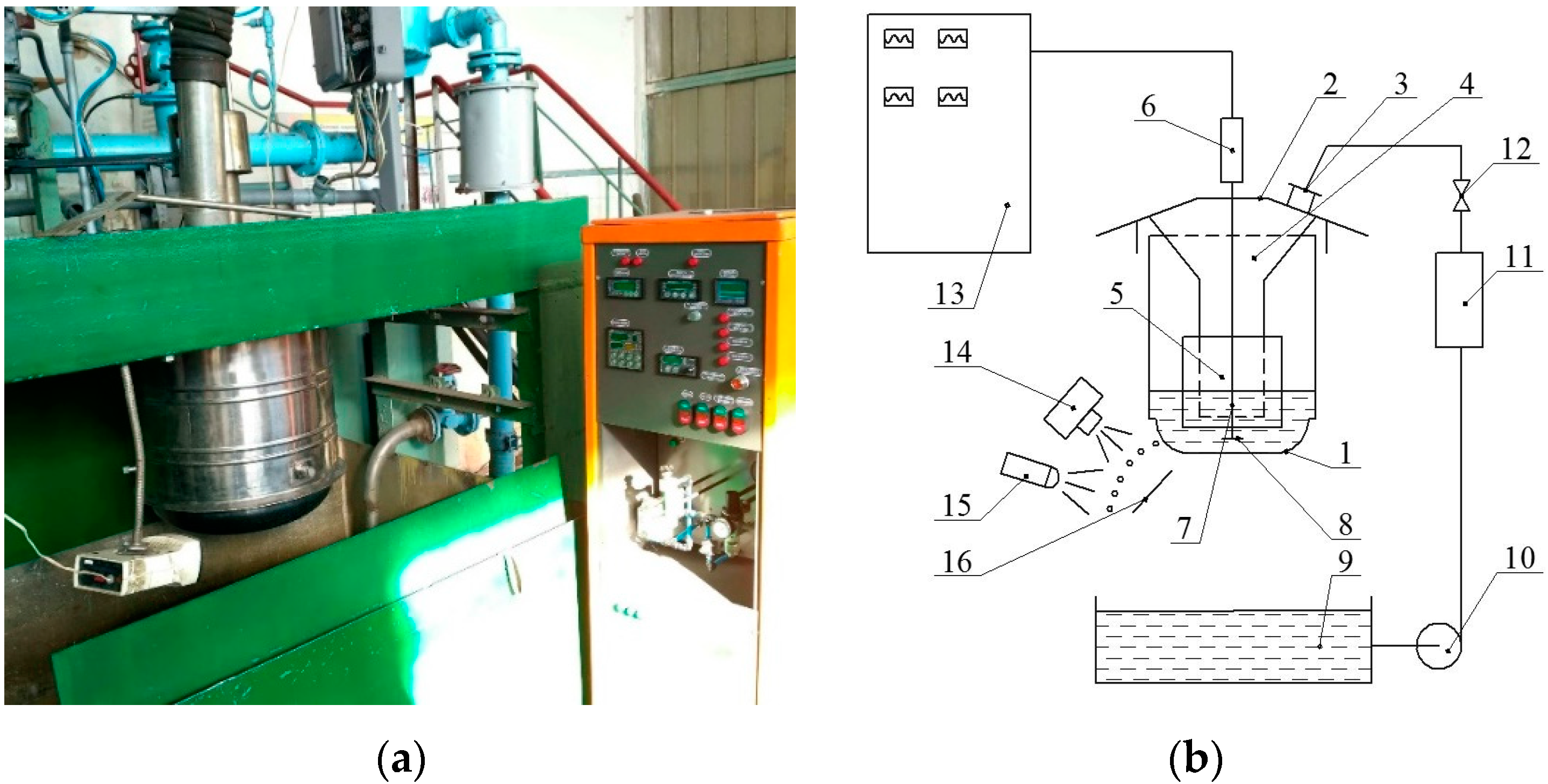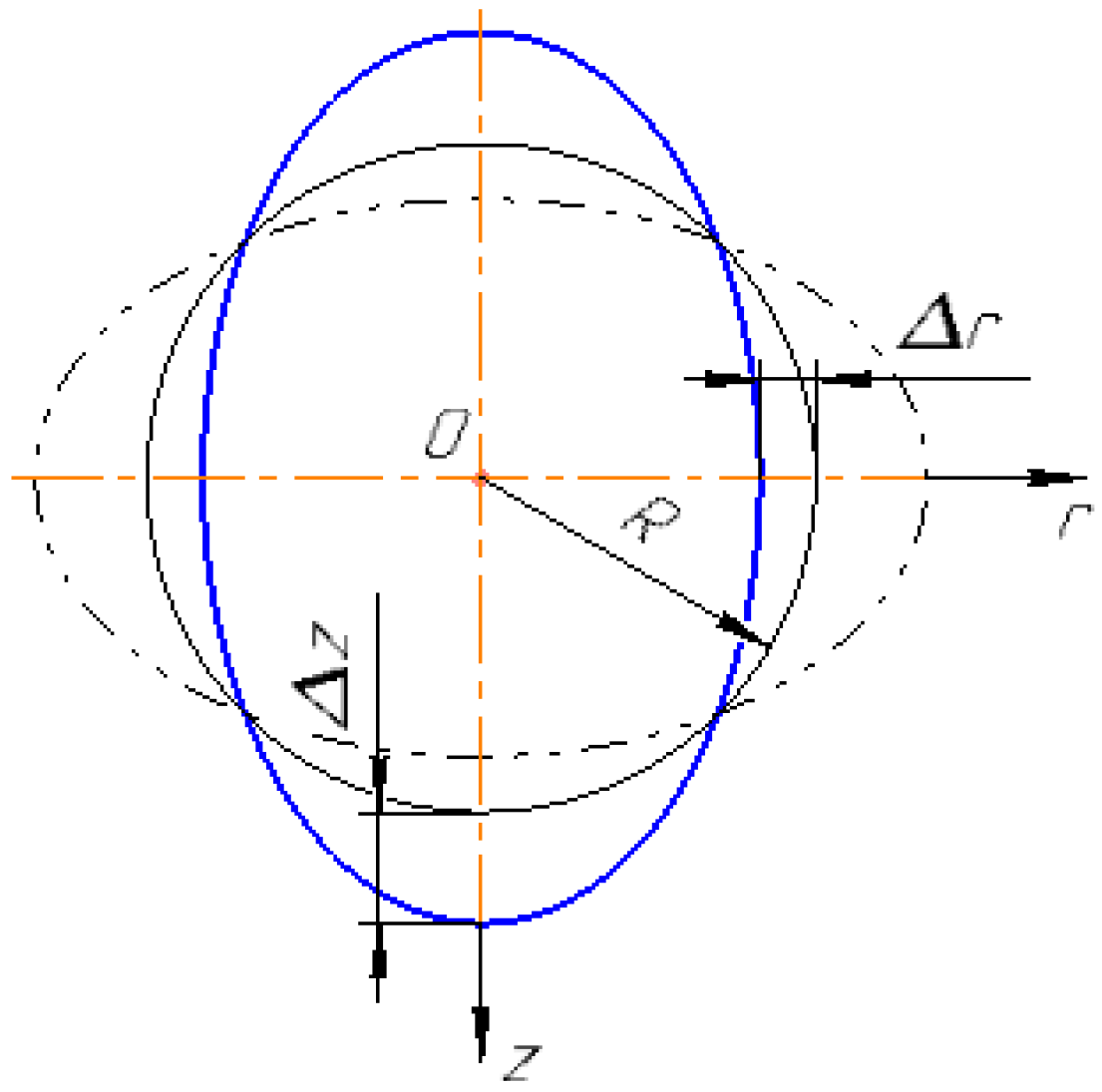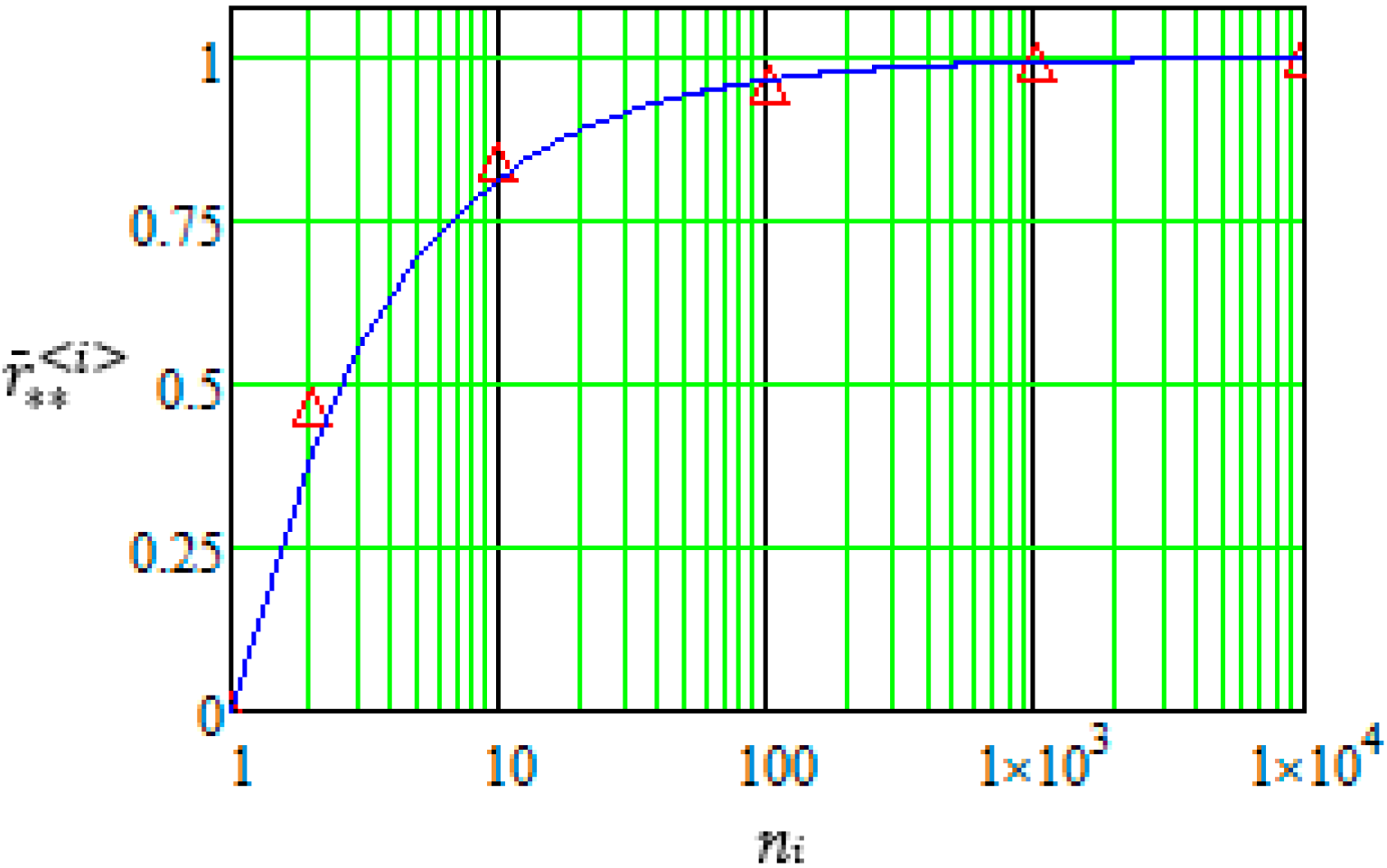Effect of Superimposed Vibrations on Droplet Oscillation Modes in Prilling Process
Abstract
1. Introduction
- Substantiation of the need for the application of vibrational prilling to create a controlled impact on the process of jet decay on droplets with a given size, shape, and the degree of monodispersity;
- Experimental research of the droplet oscillation modes for the different frequencies;
- Creation of a refined mathematical model of droplet deformation;
- Determination of analytical dependencies to determine velocity components under experimentally obtained peculiarities of droplet deformation;
- Obtaining a condition for the droplet shape stability and evaluating the characteristics of their secondary decay.
2. Materials and Methods
3. Results
4. Discussion and Conclusions
Author Contributions
Funding
Conflicts of Interest
References
- Wu, Y.; Bao, C.; Zhou, Y. An innovated tower-fluidized bed prilling process. Chin. J. Chem. Eng. 2007, 15, 424–428. [Google Scholar] [CrossRef]
- Wang, Y.; Jiang, X.W.; Yuan, H. Process calculation of mechanical ventilation prilling tower for ammonium nitrate. Huaxue Gongcheng Chem. Eng. 2013, 41, 69–74. [Google Scholar] [CrossRef] [PubMed][Green Version]
- Saito, S.; Abe, Y.; Kaneko, A.; Kanagawa, T.; Iwasawa, Y.; Matsuo, E.; Ebihara, K.I.; Sakaba, H.; Koyama, K.; Nariai, H. Experimental study on jet instability and breakup behavior in liquid-liquid system. In Proceedings of the International Conference on Nuclear Engineering, ICONE, Chiba, Japan, 21 May 2015; American Society of Mechanical Engineers (ASME): New York, NY, USA, 2015; Volume 2015, p. 118695. [Google Scholar]
- Cheong, B.S.; Howes, T. Capillary jet instability under the influence of gravity. Chem. Eng. Sci. 2004, 59, 2145–2157. [Google Scholar] [CrossRef]
- Yang, M.; Yan, L.; Wang, Y.; Gong, C.; Lu, J. Instability and interfacial coherent structure of free round turbulent jet. Nongye Jixie Xuebao Trans. Chin. Soc. Agric. Mach. 2016, 47, 35–44. [Google Scholar]
- Sanyal, A.; Basu, S. Evaporation excites temporal sequence of resonant modes in a sessile droplet perturbed at constant frequency – Insights into the universal dynamics of mode transitions. Chem. Eng. Sci. 2018, 176, 294–305. [Google Scholar] [CrossRef]
- Hoffmann, T.; Rieck, C.; Bück, A.; Peglow, M.; Tsotsas, E. Influence of granule porosity during fluidized bed spray granulation. Procedia Eng. 2015, 102, 458–467. [Google Scholar] [CrossRef]
- Chen, C.W.; Lee, T. Round Granules of Dimethyl Fumarate by Three-in-One Intensified Process of Reaction, Crystallization, and Spherical Agglomeration in a Common Stirred Tank. Org. Process Res. Dev. 2017, 21, 1326–1339. [Google Scholar] [CrossRef]
- Zhang, L.; Liu, W.; Zhang, Y. Calculation of teeter bed height of teetered bed separator based on jet theory. Powder Technol. 2016, 295, 225–233. [Google Scholar] [CrossRef]
- Zhang, X.; Cao, S.; Li, D. Study of integrated dust control and dust removal technology based on wall-attached jet theory. Zhongguo Kuangye Daxue Xuebao J. China Univ. Min. Technol. 2019, 48, 495–502. [Google Scholar]
- Skydanenko, M.; Sklabinskyi, V.; Saleh, S. CFD simulation of ammonium nitrate melt in a perforated rotating bucket. In Advances in Design, Simulation and Manufacturing (DSMIE 2018). Lecture Notes in Mechanical Engineering; Ivanov, V., Rong, Y., Trojanowska, J., Venus, J., Liaposhchenko, O., Zajac, J., Pavlenko, I., Edl, M., Peraković, D., Eds.; Springer: Cham, Switzerland, 2019; pp. 498–506. [Google Scholar]
- Vakal, V.; Pavlenko, I.; Vakal, S.; Hurets, L.; Ochowiak, M. Mathematical Modeling of Nutrient Release from Capsulated Fertilizers. Period. Polytech. Chem. Eng. 2019. [Google Scholar] [CrossRef]
- Skydanenko, M.; Sklabinskyi, V.; Saleh, S.; Barghi, S. Reduction of dust emission by monodisperse system technology for ammonium nitrate manufacturing. Processes 2017, 5, 37. [Google Scholar] [CrossRef]
- Li, W.; Wang, Y.; Mumford, K.A.; Smith, K.H.; Stevens, G.W. Comparison of the axial dispersion performance of pulsed solvent extraction columns with Tenova pulsed column–kinetics internals and standard disc and doughnut internals. Solvent Extr. Ion Exch. 2018, 36, 387–400. [Google Scholar] [CrossRef]
- Asadollahzadeh, M.; Hemmati, A.; Torab-Mostaedi, M.; Shirvani, M.; Ghaemi, A.; Mohsenzadeh, Z.S. Use of axial dispersion model for determination of Sherwood number and mass transfer coefficients in a perforated rotating disc contactor. Chin. J. Chem. Eng. 2017, 25, 53–61. [Google Scholar] [CrossRef]
- Khovanskyi, S.; Pavlenko, I.; Pitel, J.; Mizakova, J.; Ochowiak, M.; Grechka, I. Solving the coupled aerodynamic and thermal problem for modeling the air distribution devices with perforated plates. Energies 2019, 12, 3488. [Google Scholar] [CrossRef]
- Ostroha, R.; Yukhymenko, M.; Lytvynenko, A.; Bocko, J.; Pavlenko, I. Granulation process of the organic suspension: Fluidized bed temperature influence on the kinetics of the granule formation. In Advances in Design, Simulation and Manufacturing (DSMIE 2018). Lecture Notes in Mechanical Engineering; Ivanov, V., Rong, Y., Trojanowska, J., Venus, J., Liaposhchenko, O., Zajac, J., Pavlenko, I., Edl, M., Peraković, D., Eds.; Springer: Cham, Switzerland, 2019; pp. 463–471. [Google Scholar]
- Merzliakov, I.; Pavlenko, I.; Chekh, O.; Sharapov, S.; Ivanov, V. Mathematical modeling of operating process and technological features for designing the vortex type liquid-vapor jet apparatus. In Advances in Design, Simulation and Manufacturing II. (DSMIE 2019). Lecture Notes in Mechanical Engineering; Ivanov, V., Trojanowska, J., Machado, J., Liaposhchenko, O., Zajac, J., Pavlenko, I., Edl, M., Perakovic, D., Eds.; Springer: Cham, Switzerland, 2020; pp. 613–622. [Google Scholar]
- Xiao, F.; Jing, J.; Kuang, S.; Yang, L.; Yu, A. Capillary forces on wet particles with a liquid bridge transition from convex to concave. Powder Technol. 2020, 363, 59–73. [Google Scholar] [CrossRef]
- Murase, K.; Arai, K.; Ootsuka, T.; Sakamoto, D.; Egawa, F. Numerical and experimental estimation on the normal and tangential capillary bridge force adhered to two spheres. In Proceedings of the Handling and Processing of Granular Systems 2018-Topical at the 8th World Congress on Particle Technology, Orlando, FL, USA, 22–26 April 2018; AIChE: New York, NY, USA, 2018; pp. 46–53. [Google Scholar]
- Wei, M.R.; Liu, F.; Wen, H.; Liu, Y.C.; Zhang, Y.S. Dispersion equation of three-dimensional unstable disturbing wave on surface of a viscous liquid jet with evaporating. Neiranji Xuebao Trans. CSICE (Chin. Soc. Intern. Combust. Engines) 2005, 23, 430–435. [Google Scholar]
- Tammisola, O.; Lundell, F.; Daniel Söderberg, L. Surface tension-induced global instability of planar jets and wakes. J. Fluid Mech. 2012, 713, 632–658. [Google Scholar] [CrossRef]
- Driessen, T.; Sleutel, P.; Dijksman, F.; Jeurissen, R.; Lohse, D. Control of jet breakup by a superposition of two Rayleigh-Plateau-unstable modes. J. Fluid Mech. 2014, 749, 275–296. [Google Scholar] [CrossRef]
- Itoh, K.; Tsuji, Y.; Nakamura, H.; Kukita, Y. Free-Surface Shear Layer Instabilities on a High-Speed Liquid Jet. Fusion Sci. Technol. 2000, 37, 74–88. [Google Scholar] [CrossRef]
- Jia, B.Q.; Xie, L.; Cui, X.; Yang, L.J.; Fu, Q.F. Linear stability of confined coaxial jets in the presence of gas velocity oscillations with heat and mass transfer. Phys. Fluids 2019, 31, 9145. [Google Scholar]
- Jiang, X.S.; Qi, L.H.; Luo, J.; Zeng, X.H. Influences of disturbance frequency on the droplet generation for microdroplet deposition manufacture. Proc. Inst. Mech. Eng. Part B J. Eng. Manuf. 2009, 223, 1529–1539. [Google Scholar] [CrossRef]
- Xie, R.; Chu, L.Y.; Chen, W.M.; Zhao, Y.; Xiao, X.C.; Wang, S. Preparation of monodispersed porous microcapsule membranes with SPG membrane emulsification and interfacial polymerization. Gao Xiao Hua Xue Gong Cheng Xue Bao J. Chem. Eng. Chin. Univ. 2003, 17, 400–405. [Google Scholar]
- Mu, K.; Si, T.; Li, E.; Xu, R.X.; Ding, H. Numerical study on droplet generation in axisymmetric flow focusing upon actuation. Phys. Fluids 2018, 30, 9601. [Google Scholar] [CrossRef]
- Chen, X.; Ren, C.L. Experimental study on droplet generation in flow focusing devices considering a stratified flow with viscosity contrast. Chem. Eng. Sci. 2017, 163, 1–10. [Google Scholar] [CrossRef]
- Fesenko, A.; Basova, Y.; Ivanov, V.; Ivanova, M.; Yevsiukova, F.; Gasanov, M. Increasing of equipment efficiency by intensification of technological processes. Period. Polytech. Mech. Eng. 2019, 63, 67–73. [Google Scholar] [CrossRef]
- Straka, L.; Panda, A. Optimal preventive maintenance schedule of slewing rings for demanding production machine. MM Sci. J. 2018, 12, 2696–2700. [Google Scholar] [CrossRef]
- Lytvynenko, A.; Yukhymenko, M.; Pavlenko, I.; Pitel, J.; Mizakova, J.; Lytvynenko, O.; Ostroha, R.; Bocko, J. Ensuring the reliability of pneumatic classification process for granular material in a rhomb-shaped apparatus. Appl. Sci. 2019, 9, 1604. [Google Scholar] [CrossRef]
- Chao, C.; Xu, G.; Fan, X. Effect of surface tension, viscosity, pore geometry and pore contact angle on effective pore throat. Chem. Eng. Sci. 2019, 197, 269–279. [Google Scholar] [CrossRef]
- Bilonoga, Y.; Maksysko, O. The laws of distribution of the values of turbulent thermo-physical characteristics in the volume of the flows of heat carriers taking into account the surface forces. Int. J. Heat Technol. 2019, 37, 1–10. [Google Scholar] [CrossRef]
- Jiang, H.; Tan, H. One-dimensional simulation of drop breakup in inkjet. In Advanced Materials-TechConnect Briefs 2017; TechConnect: San Juan Capistrano, CA, USA, 2017; Volume 4, pp. 128–132. [Google Scholar]
- Nazari, A.; Nazari, A. Experimental investigation on Newtonian drop formation in different continuous phase fluids. In Proceedings of the ASME International Mechanical Engineering Congress and Exposition, Proceedings (IMECE), Pittsburgh, PA, USA, 9–15 November 2018; American Society of Mechanical Engineers (ASME): New York, NY, USA,, 2018; Volume 7, p. 144113. [Google Scholar]
- Rajendran, S.; Jog, M.A.; Manglik, R.M. Experimental investigation of jet breakup at low weber number. At. Sprays 2017, 27, 821–834. [Google Scholar] [CrossRef]
- Tothova, M.; Pitel, J. Dynamic simulation of pneumatic muscle actuator in Matlab/Simulink environment. In Proceedings of the 2014 IEEE 12th International Symposium on Intelligent Systems and Informatics (SISY), Subotica, Serbia, 11–13 September 2014; pp. 209–213. [Google Scholar]
- Mižáková, J.; Piteľ, J.; Hošovský, A.; Kolarčík, M.; Ratnayake, M. Using special filter with membership function in biomass combustion process control. Appl. Sci. 2018, 8, 1279. [Google Scholar] [CrossRef]
- Zidek, K.; Maxim, V.; Pitel, J.; Hosovsky, A. Embedded vision equipment of industrial robot for inline detection of product errors by clustering-classification algorithms. Int. J. Adv. Robot. Syst. 2016, 13, 4901. [Google Scholar] [CrossRef]







© 2020 by the authors. Licensee MDPI, Basel, Switzerland. This article is an open access article distributed under the terms and conditions of the Creative Commons Attribution (CC BY) license (http://creativecommons.org/licenses/by/4.0/).
Share and Cite
Pavlenko, I.; Sklabinskyi, V.; Piteľ, J.; Židek, K.; Kuric, I.; Ivanov, V.; Skydanenko, M.; Liaposhchenko, O. Effect of Superimposed Vibrations on Droplet Oscillation Modes in Prilling Process. Processes 2020, 8, 566. https://doi.org/10.3390/pr8050566
Pavlenko I, Sklabinskyi V, Piteľ J, Židek K, Kuric I, Ivanov V, Skydanenko M, Liaposhchenko O. Effect of Superimposed Vibrations on Droplet Oscillation Modes in Prilling Process. Processes. 2020; 8(5):566. https://doi.org/10.3390/pr8050566
Chicago/Turabian StylePavlenko, Ivan, Vsevolod Sklabinskyi, Ján Piteľ, Kamil Židek, Ivan Kuric, Vitalii Ivanov, Maksym Skydanenko, and Oleksandr Liaposhchenko. 2020. "Effect of Superimposed Vibrations on Droplet Oscillation Modes in Prilling Process" Processes 8, no. 5: 566. https://doi.org/10.3390/pr8050566
APA StylePavlenko, I., Sklabinskyi, V., Piteľ, J., Židek, K., Kuric, I., Ivanov, V., Skydanenko, M., & Liaposhchenko, O. (2020). Effect of Superimposed Vibrations on Droplet Oscillation Modes in Prilling Process. Processes, 8(5), 566. https://doi.org/10.3390/pr8050566









